Abstract
The binding of 125I-labeled human myeloma immunoglobulin A (IgA) to four type II strains and one nontypable strain of group B streptococci was measured after streptococcal chains were broken by brief sonication. Some IgA binding was observed with all strains, but specific binding (binding that was inhibited by excess unlabeled IgA, was dose dependent, and was saturable) occurred only with those strains possessing the trypsin-sensitive beta component of the c protein. Similar amounts of binding were observed with myeloma IgA and IgA1 purified from normal serum. Specific binding was more rapid at 25 degrees C than at 0 or 37 degrees C and reached a plateau in 6 to 8 h. Binding was drastically reduced (85 to 90%) when streptococci had been heated (90 degrees C for 1 h). Most radioactivity bound to group B streptococci could be displaced (greater than 60% in 3 days) by the addition of excess unlabeled IgA. The binding capacity of one strain (10(8) streptococci in 1 ml of buffer) was saturated by approximately 24 micrograms of IgA. When transformed for Scatchard analysis, these data indicated that there was a specific binding capacity of 16,000 molecules of monomeric serum IgA per single streptococcal cell. The dissociation constant for IgA binding was 19.3 nM. Since enzyme-linked immunosorbent assay studies showed that the myeloma IgA used for the studies described above was IgA1, our quantitative data apply only to the binding of this subclass to group B streptococci. However, an enzyme-linked immunosorbent-filtration assay showed that both IgA1 and IgA2 bound to a type II group B streptococcus bearing the c protein.
Full text
PDF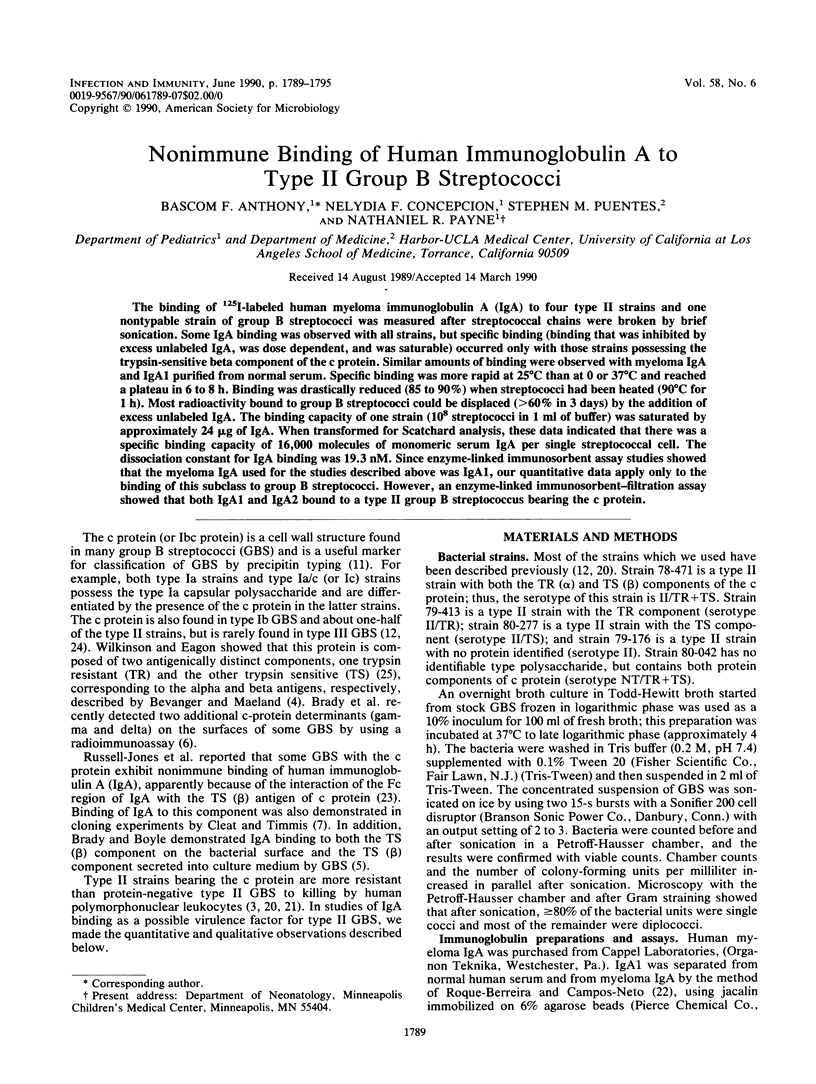

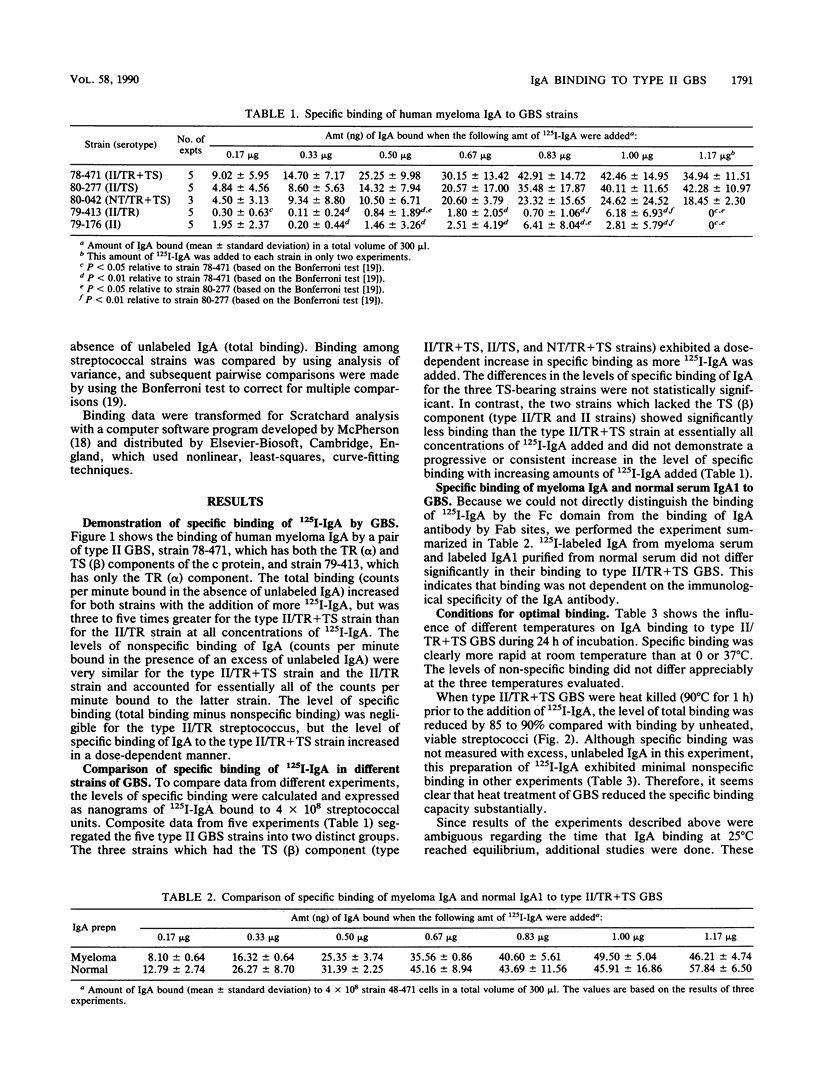
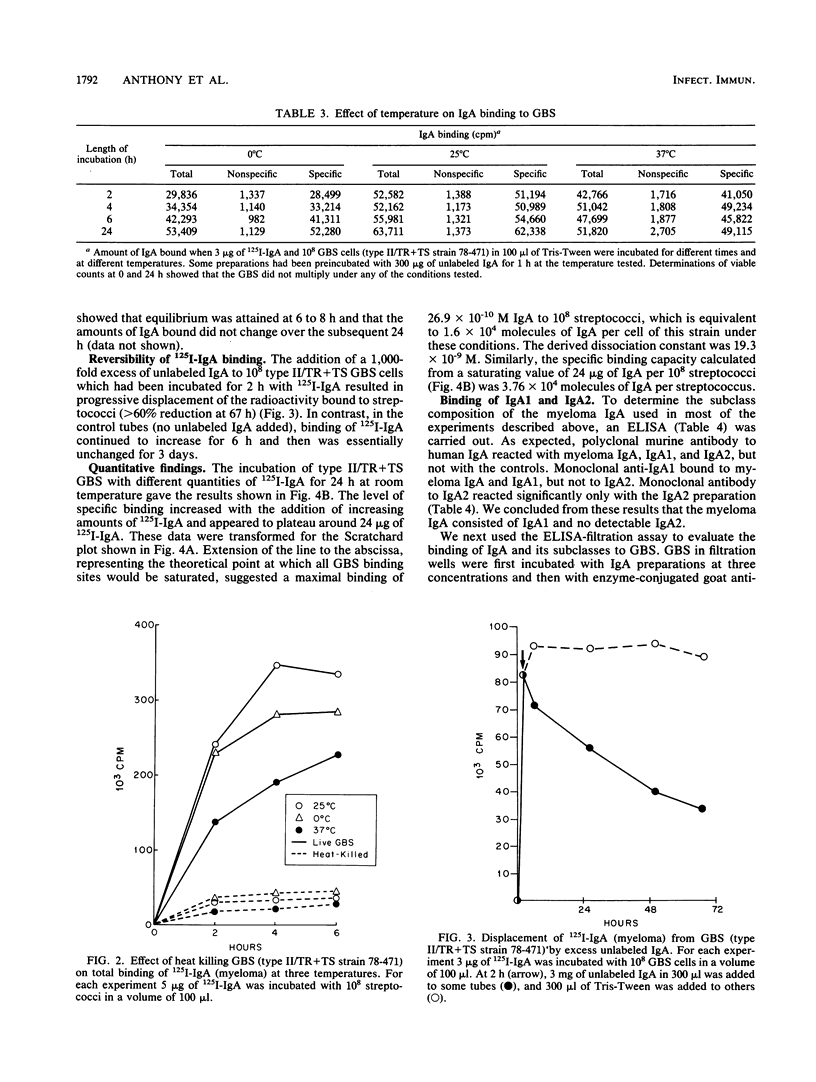
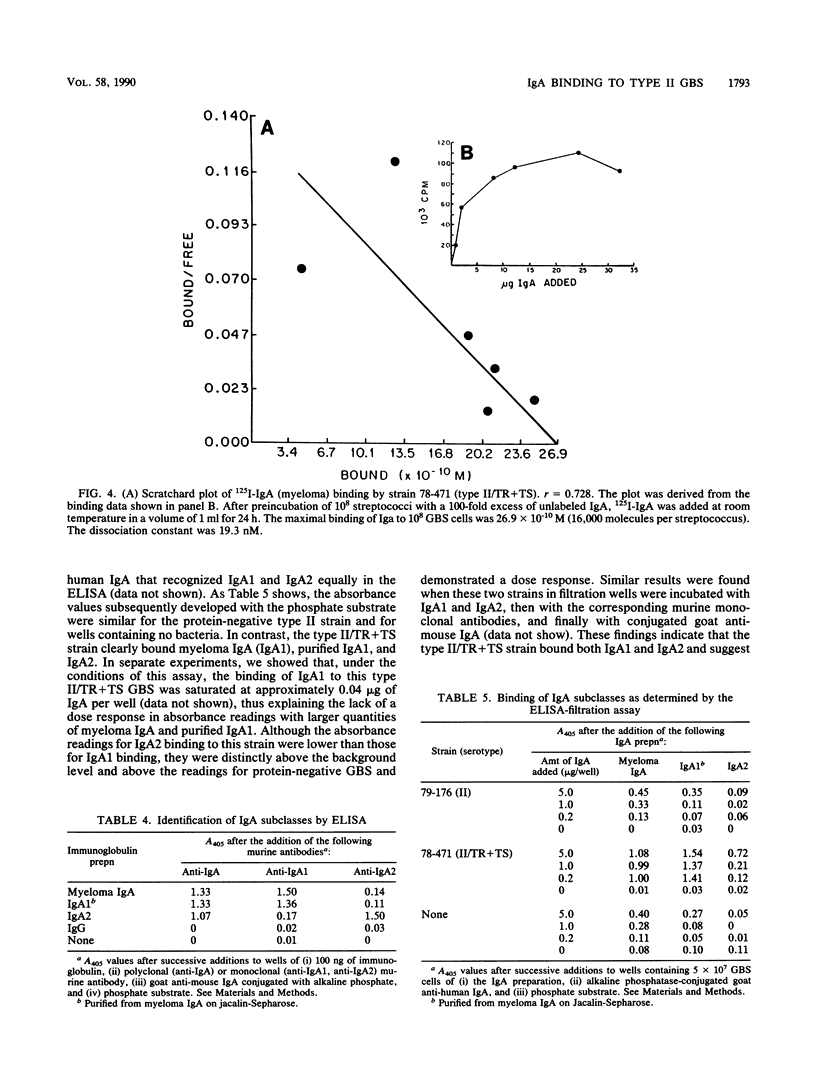
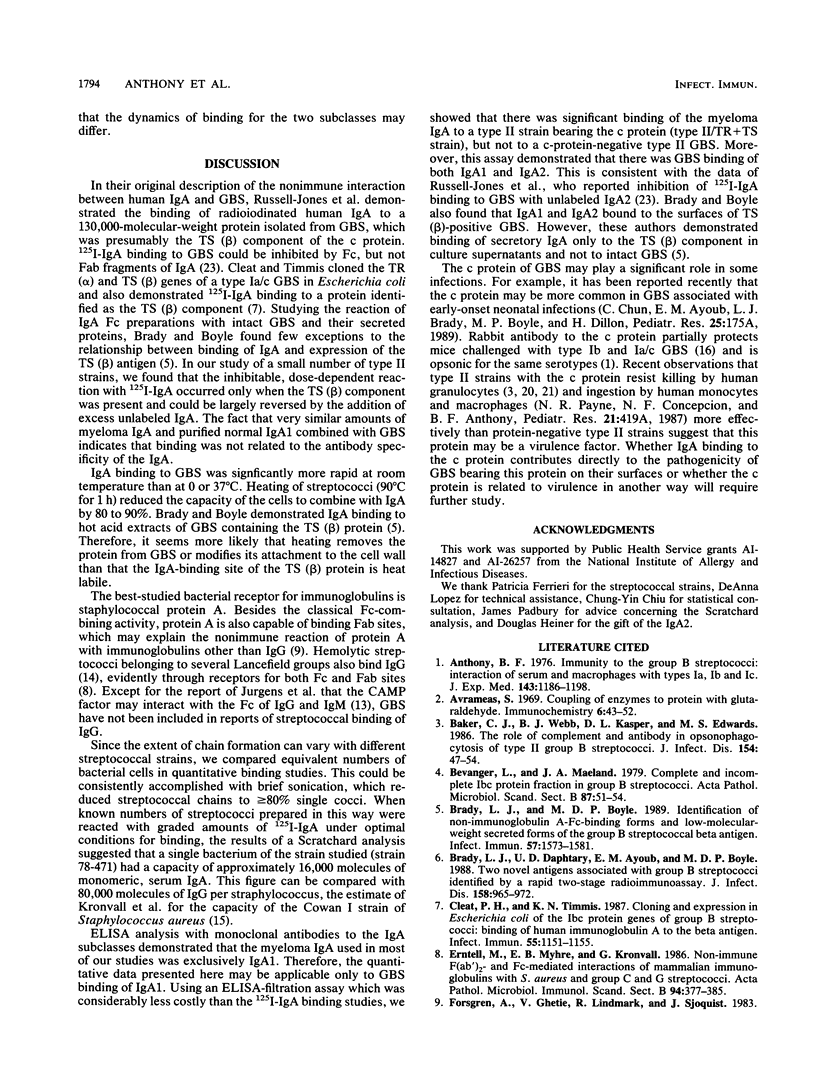

Selected References
These references are in PubMed. This may not be the complete list of references from this article.
- Anthony B. F. Immunity to the group B streptococci: interaction of serum and macrophages with types Ia, Ib, and Ic. J Exp Med. 1976 May 1;143(5):1186–1198. doi: 10.1084/jem.143.5.1186. [DOI] [PMC free article] [PubMed] [Google Scholar]
- Avrameas S. Coupling of enzymes to proteins with glutaraldehyde. Use of the conjugates for the detection of antigens and antibodies. Immunochemistry. 1969 Jan;6(1):43–52. doi: 10.1016/0019-2791(69)90177-3. [DOI] [PubMed] [Google Scholar]
- Baker C. J., Webb B. J., Kasper D. L., Edwards M. S. The role of complement and antibody in opsonophagocytosis of type II group B streptococci. J Infect Dis. 1986 Jul;154(1):47–54. doi: 10.1093/infdis/154.1.47. [DOI] [PubMed] [Google Scholar]
- Bevanger L., Maeland J. A. Complete and incomplete Ibc protein fraction in group B streptococci. Acta Pathol Microbiol Scand B. 1979 Feb;87B(1):51–54. doi: 10.1111/j.1699-0463.1979.tb02402.x. [DOI] [PubMed] [Google Scholar]
- Brady L. J., Boyle M. D. Identification of non-immunoglobulin A-Fc-binding forms and low-molecular-weight secreted forms of the group B streptococcal beta antigen. Infect Immun. 1989 May;57(5):1573–1581. doi: 10.1128/iai.57.5.1573-1581.1989. [DOI] [PMC free article] [PubMed] [Google Scholar]
- Brady L. J., Daphtary U. D., Ayoub E. M., Boyle M. D. Two novel antigens associated with group B streptococci identified by a rapid two-stage radioimmunoassay. J Infect Dis. 1988 Nov;158(5):965–972. doi: 10.1093/infdis/158.5.965. [DOI] [PubMed] [Google Scholar]
- Cleat P. H., Timmis K. N. Cloning and expression in Escherichia coli of the Ibc protein genes of group B streptococci: binding of human immunoglobulin A to the beta antigen. Infect Immun. 1987 May;55(5):1151–1155. doi: 10.1128/iai.55.5.1151-1155.1987. [DOI] [PMC free article] [PubMed] [Google Scholar]
- Erntell M., Myhre E. B., Kronvall G. Non-immune F(ab')2- and Fc-mediated interactions of mammalian immunoglobulins with S. aureus and group C and G streptococci. Acta Pathol Microbiol Immunol Scand B. 1986 Dec;94(6):377–385. doi: 10.1111/j.1699-0463.1986.tb03071.x. [DOI] [PubMed] [Google Scholar]
- Gregory R. L., Rundegren J., Arnold R. R. Separation of human IgA1 and IgA2 using jacalin-agarose chromatography. J Immunol Methods. 1987 May 4;99(1):101–106. doi: 10.1016/0022-1759(87)90037-8. [DOI] [PubMed] [Google Scholar]
- Johnson D. R., Ferrieri P. Group B streptococcal Ibc protein antigen: distribution of two determinants in wild-type strains of common serotypes. J Clin Microbiol. 1984 Apr;19(4):506–510. doi: 10.1128/jcm.19.4.506-510.1984. [DOI] [PMC free article] [PubMed] [Google Scholar]
- Jürgens D., Sterzik B., Fehrenbach F. J. Unspecific binding of group B streptococcal cocytolysin (CAMP factor) to immunoglobulins and its possible role in pathogenicity. J Exp Med. 1987 Mar 1;165(3):720–732. doi: 10.1084/jem.165.3.720. [DOI] [PMC free article] [PubMed] [Google Scholar]
- Kronvall G., Quie P. G., Williams R. C., Jr Quantitation of staphylococcal protein A: Determination of equilibrium constant and number of protein A residues on bacteria. J Immunol. 1970 Feb;104(2):273–278. [PubMed] [Google Scholar]
- Lancefield R. C., McCarty M., Everly W. N. Multiple mouse-protective antibodies directed against group B streptococci. Special reference to antibodies effective against protein antigens. J Exp Med. 1975 Jul 1;142(1):165–179. doi: 10.1084/jem.142.1.165. [DOI] [PMC free article] [PubMed] [Google Scholar]
- Markwell M. A. A new solid-state reagent to iodinate proteins. I. Conditions for the efficient labeling of antiserum. Anal Biochem. 1982 Sep 15;125(2):427–432. doi: 10.1016/0003-2697(82)90025-2. [DOI] [PubMed] [Google Scholar]
- McPherson G. A. Analysis of radioligand binding experiments. A collection of computer programs for the IBM PC. J Pharmacol Methods. 1985 Nov;14(3):213–228. doi: 10.1016/0160-5402(85)90034-8. [DOI] [PubMed] [Google Scholar]
- Payne N. R., Ferrieri P. The relation of the Ibc protein antigen to the opsonization differences between strains of type II group B streptococci. J Infect Dis. 1985 Apr;151(4):672–681. doi: 10.1093/infdis/151.4.672. [DOI] [PubMed] [Google Scholar]
- Payne N. R., Kim Y. K., Ferrieri P. Effect of differences in antibody and complement requirements on phagocytic uptake and intracellular killing of "c" protein-positive and -negative strains of type II group B streptococci. Infect Immun. 1987 May;55(5):1243–1251. doi: 10.1128/iai.55.5.1243-1251.1987. [DOI] [PMC free article] [PubMed] [Google Scholar]
- Roque-Barreira M. C., Campos-Neto A. Jacalin: an IgA-binding lectin. J Immunol. 1985 Mar;134(3):1740–1743. [PubMed] [Google Scholar]
- Russell-Jones G. J., Gotschlich E. C., Blake M. S. A surface receptor specific for human IgA on group B streptococci possessing the Ibc protein antigen. J Exp Med. 1984 Nov 1;160(5):1467–1475. doi: 10.1084/jem.160.5.1467. [DOI] [PMC free article] [PubMed] [Google Scholar]
- Wilkinson H. W. Analysis of group B streptococcal types associated with disease in human infants and adults. J Clin Microbiol. 1978 Feb;7(2):176–179. doi: 10.1128/jcm.7.2.176-179.1978. [DOI] [PMC free article] [PubMed] [Google Scholar]
- Wilkinson H. W., Eagon R. G. Type-specific antigens of group B type Ic streptococci. Infect Immun. 1971 Nov;4(5):596–604. doi: 10.1128/iai.4.5.596-604.1971. [DOI] [PMC free article] [PubMed] [Google Scholar]


